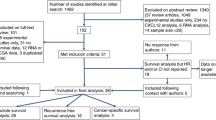Abstract
The purpose of this study was to investigate the expression of CXCL12 and its receptor CXCR4 in gastric cancer and to determine their relationship with lymph node metastasis. Fifty patients with pathologically confirmed gastric cancer were analyzed from September 2004 to December 2004. The expression levels of CXCL12 and CXCR4 were examined by immunohistochemical staining in the primary gastric tumor tissues, adjacent normal mucosa tissues, and metastatic lymph nodes and were analyzed along with clinicopathological risk factors, to determine their correlation with the prognosis. Positive staining for CXCL12 and CXCR4 was identified in 90.0 and 80.0% of the primary gastric tumor tissues, respectively, with significantly higher expression intensities observed in the primary gastric tumor tissues than in the adjacent normal mucosa tissues (P < 0.01 and P = 0.01, respectively). Positive staining for CXCL12 and CXCR4 was identified in 94.4 and 91.7% of metastatic lymph nodes, respectively, with significantly higher expression intensities in the metastatic lymph nodes than in the adjacent normal mucosa tissues (P < 0.01 and P = 0.01, respectively). Expression of CXCL12 in the primary gastric tumor tissues was not significantly associated with the clinicopathological characteristics of the tumor or the disease prognosis. However, the intensity of CXCR4 staining in primary tumor tissues was positively related with lymph node metastasis, TNM staging, and disease prognosis (P = 0.04, 0.03, 0.03, respectively). CXCL12 and CXCR4 are related to formation of gastric tumors and lymph node metastasis. Furthermore, the expression of CXCR4 could be used as a biomarker to predict malignant features of gastric cancer.








Similar content being viewed by others
References
Jemal A, Siegel R, Xu J, Ward E. Cancer statistics, 2010. CA Cancer J Clin. 2010;60:277–300.
Hundahl SA, Phillips JL, Menck HR. The national cancer data base report on poor survival of US gastric carcinoma patients treated with gastrectomy: fifth edition American joint committee on cancer staging, proximal disease, and the “different disease” hypothesis. Cancer. 2000;88:921–32.
Dimberg J, Hugander A, Lofgren S, Wagsater D. Polymorphism and circulating levels of the chemokine CXCL12 in colorectal cancer patients. Int J Mol Med. 2007;19:11–5.
Balkwill F. The significance of cancer cell expression of the chemokine receptor CXCR4. Semin Cancer Biol. 2004;14:171–9.
Viola A, Luster AD. Chemokines and their receptors: drug targets in immunity and inflammation. Annu Rev Pharmacol Toxicol. 2008;48:171–97.
Lagerstrom MC, Schioth HB. Structural diversity of G protein-coupled receptors and significance for drug discovery. Nat Rev Drug Discov. 2008;7:339–57.
Ratajczak MZ, et al. The pleiotropic effects of the SDF-1-CXCR4 axis in organogenesis, regeneration and tumorigenesis. Leukemia. 2006;20:1915–24.
Petit I, Jin D, Rafii S. The SDF-1-CXCR4 signaling pathway: a molecular hub modulating neo-angiogenesis. Trends Immunol. 2007;28:299–307.
Nagasawa T, Tachibana K, Kishimoto T. A novel CXC chemokine PBSF/SDF-1 and its receptor CXCR4: their functions in development, hematopoiesis and HIV infection. Semin Immunol. 1998;10:179–85.
Remmele W, Stegner HE. Recommendation for uniform definition of an immunoreactive score (IRS) for immunohistochemical estrogen receptor detection (ER-ICA) in breast cancer tissue. Pathologe. 1987;8:138–40.
Muller A, et al. Involvement of chemokine receptors in breast cancer metastasis. Nature. 2001;410:50–6.
Sung B, et al. Zerumbone down-regulates chemokine receptor CXCR4 expression leading to inhibition of CXCL12-induced invasion of breast and pancreatic tumor cells. Cancer Res. 2008;68:8938–44.
Otsuka S, Bebb G. The CXCR4/SDF-1 chemokine receptor axis: a new target therapeutic for non-small cell lung cancer. J Thorac Oncol. 2008;3:1379–83.
Schrader AJ, et al. CXCR4/CXCL12 expression and signalling in kidney cancer. Br J Cancer. 2002;86:1250–6.
Onoue T, et al. Epithelial-mesenchymal transition induced by the stromal cell-derived factor-1/CXCR4 system in oral squamous cell carcinoma cells. Int J Oncol. 2006;29:1133–8.
Schimanski CC, et al. Dissemination of hepatocellular carcinoma is mediated via chemokine receptor CXCR4. Br J Cancer. 2006;95:210–7.
Yoshitake N, et al. Expression of SDF-1 alpha and nuclear CXCR4 predicts lymph node metastasis in colorectal cancer. Br J Cancer. 2008;98:1682–9.
Ishigami S, et al. Clinical implication of CXCL12 expression in gastric cancer. Ann Surg Oncol. 2007;14:3154–8.
Kwak MK, et al. Expression of chemokine receptors in human gastric cancer. Tumour Biol. 2005;26:65–70.
Yasumoto K, et al. Role of the CXCL12/CXCR4 axis in peritoneal carcinomatosis of gastric cancer. Cancer Res. 2006;66:2181–7.
Lee HJ, et al. Chemokine receptor CXCR4 expression, function, and clinical implications in gastric cancer. Int J Oncol. 2009;34:473–80.
Arigami T, et al. CCR7 and CXCR4 expression predicts lymph node status including micrometastasis in gastric cancer. Int J Oncol. 2009;35:19–24.
Rosenkilde MM, et al. Molecular mechanism of AMD3100 antagonism in the CXCR4 receptor: transfer of binding site to the CXCR3 receptor. J Biol Chem. 2004;279:3033–41.
Liang Z, et al. Silencing of CXCR4 blocks breast cancer metastasis. Cancer Res. 2005;65:967–71.
Acknowledgments
This project was financially supported by Zhejiang Province Medical and Scientific Research Foundation. We would like to thank Xiaojia Wang for advice. We would also like to thank Wengyong Sun, Meijuan Wu, and Chang Shi for their support. Written consent for publication was obtained from the patient or their relative.
Conflict of interest
The authors declare that they have no conflict of interest.
Author information
Authors and Affiliations
Corresponding author
Rights and permissions
About this article
Cite this article
Ying, J., Xu, Q., Zhang, G. et al. The expression of CXCL12 and CXCR4 in gastric cancer and their correlation to lymph node metastasis. Med Oncol 29, 1716–1722 (2012). https://doi.org/10.1007/s12032-011-9990-0
Received:
Accepted:
Published:
Issue Date:
DOI: https://doi.org/10.1007/s12032-011-9990-0




